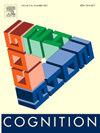语音感知策略瞬息万变
IF 2.8
1区 心理学
Q1 PSYCHOLOGY, EXPERIMENTAL
引用次数: 0
摘要
为了感知语音,听者必须决定如何优先处理来自多个声学维度的信息。在语言学习过程中,个体形成了稳定的感知策略,这反映了特定声学维度和语言类别上的值之间的统计关系的强度。尽管这种潜在的稳定性,听众会改变他们的策略,以回应证据的变化声学维度的可靠性作为线索的分类。在这里,我们展示了这样的改变是最有效的:听者在听到一个声音线索之间的关系偏离预期模式的单一刺激后,会对他们的策略做出微小的调整。此外,这些策略上的转变出现的速度和消失的速度一样快,在回到基线之前只持续一次试验。最后,我们发现线索权重的变化对分心是有抵抗力的,在安静和信息掩蔽的情况下,这种变化同样发生。因此,语音感知策略具有短期波动和长期稳定的特点。本文章由计算机程序翻译,如有差异,请以英文原文为准。
Speech perception strategies shift instantly
To perceive speech listeners must decide how to prioritize information from multiple acoustic dimensions. Over the course of language learning, individuals form stable perceptual strategies which reflect the strength of the statistical relationship between values along particular acoustic dimensions and linguistic categories. Despite this underlying stability, listeners will change their strategies in response to evidence about shifts in the reliability of acoustic dimensions as cues to categorization. Here we show that such changes are maximally efficient: listeners will make small adjustments to their strategies after hearing just a single stimulus in which the relationship between acoustic cues diverges from the expected pattern. Furthermore, these shifts in strategy vanish as quickly as they appear, lasting only a single trial before returning to baseline. Finally, we show that shifts in cue weighting are resistant to distraction, occurring equally when speech is presented in quiet versus in informational masking. Speech perception strategies, therefore, are characterized by short-term fluctuation and long-term stability.
求助全文
通过发布文献求助,成功后即可免费获取论文全文。
去求助
来源期刊

Cognition
PSYCHOLOGY, EXPERIMENTAL-
CiteScore
6.40
自引率
5.90%
发文量
283
期刊介绍:
Cognition is an international journal that publishes theoretical and experimental papers on the study of the mind. It covers a wide variety of subjects concerning all the different aspects of cognition, ranging from biological and experimental studies to formal analysis. Contributions from the fields of psychology, neuroscience, linguistics, computer science, mathematics, ethology and philosophy are welcome in this journal provided that they have some bearing on the functioning of the mind. In addition, the journal serves as a forum for discussion of social and political aspects of cognitive science.
 求助内容:
求助内容: 应助结果提醒方式:
应助结果提醒方式:


